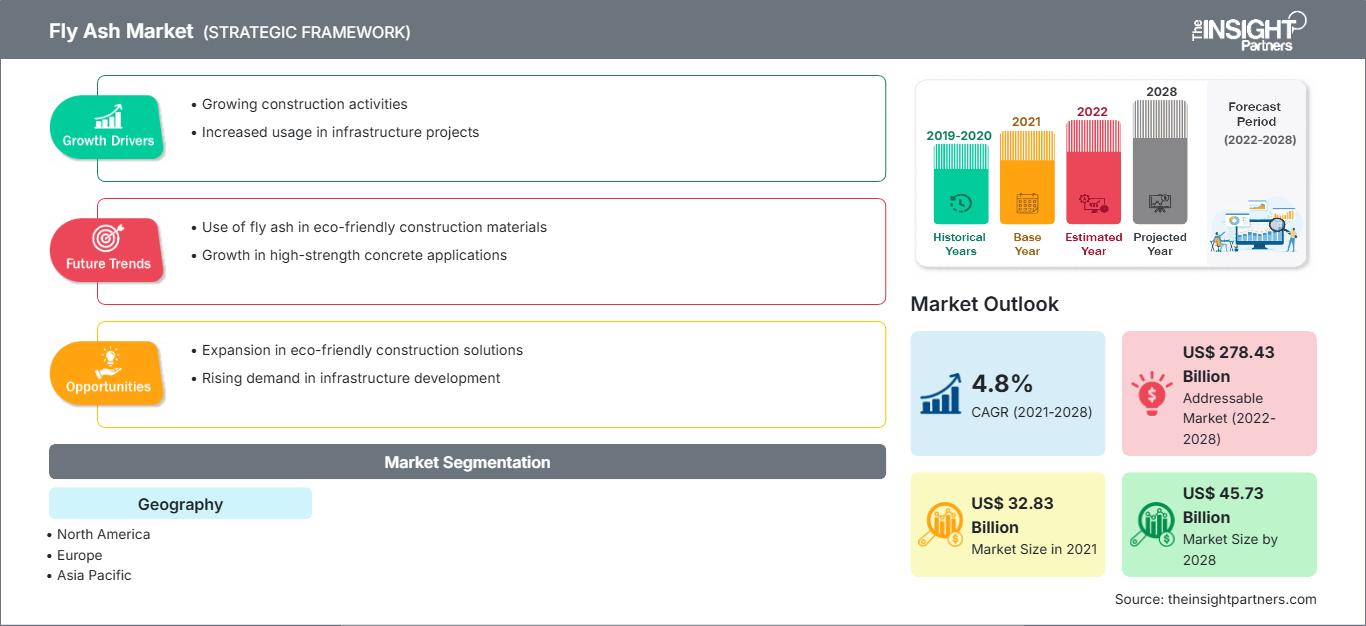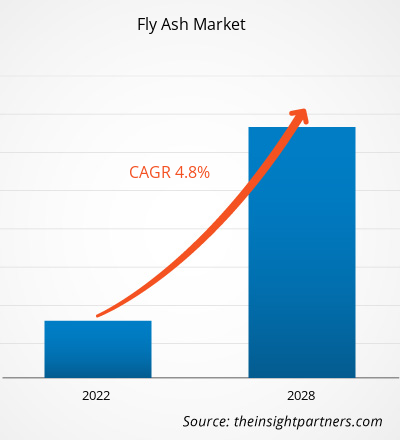[Rapport de recherche] Le marché des cendres volantes était évalué à 32,83 milliards de dollars américains en 2021 et devrait atteindre 45,73 milliards de dollars américains d'ici 2028 ; il devrait croître à un TCAC de 4,8 % entre 2021 et 2028.
ANALYSE DE MARCHÉ
Les cendres volantes sont produites comme résidu de combustion et contiennent de fines particules telles que le dioxyde de silicium, l'oxyde d'aluminium, l'oxyde ferrique et parfois l'oxyde de calcium. Il s'agit d'une fine poudre grise aux propriétés pouzzolaniques qui peut réagir avec la chaux pour former des composés de ciment. Elles sont utilisées dans un large éventail d'applications telles que le mélange de ciment et de béton, les mines et les barrages, les décharges, le béton géopolymère, entre autres. Il améliore les performances du béton lors du malaxage et agit également comme catalyseur pour la conversion du polyéthylène lors de la pyrolyse.
MOTEURS DE CROISSANCE ET DÉFIS
La croissance constante du secteur de la construction stimule considérablement la croissance du marché mondial des cendres volantes. Les pays d'Asie-Pacifique, tels que les États-Unis, la Chine et l'Inde, possèdent les plus grands secteurs de la construction au monde. Le rythme élevé des activités de construction crée une demande énorme pour divers matériaux de construction. Les cendres volantes sont utilisées dans de nombreuses applications spécifiques à la construction, telles que le ciment, le béton, les briques et les blocs. On les utilise de plus en plus pour diverses applications dans le secteur de la construction. De plus, l'utilisation croissante des cendres volantes dans diverses applications stimule encore la croissance du marché mondial des cendres volantes. Les cendres volantes sont utilisées dans diverses applications telles que le ciment et le béton, les blocs et les briques, l'exploitation minière, les remblais et les remblais, et bien d'autres. En raison de leur caractère pouzzolanique, l'utilisation de cendres volantes dans le béton est très bénéfique, car elle améliore la durabilité du béton. Dans la fabrication du béton de ciment Portland, les cendres volantes sont utilisées comme ajout cimentaire (ACM) pour améliorer les performances de ce béton. Les briques de cendres volantes remplacent les briques d'argile comme matériau de construction. Comparées aux briques d'argile traditionnelles, les briques de cendres volantes sont plus légères et plus robustes, économiques, ne nécessitent pas d'enduit et peuvent contribuer à réduire les coûts de construction et l'érosion des sols. Cependant, la méconnaissance des avantages et des utilisations potentielles des cendres volantes pourrait limiter leur croissance. Les cendres volantes sont une matière première importante pour de nombreuses applications. Cependant, la chimie des cendres volantes et de leurs dérivés est mal comprise pour une utilisation optimale. Le manque de sensibilisation du public à ces produits est l'une des causes de leur faible utilisation.
Vous bénéficierez d’une personnalisation sur n’importe quel rapport - gratuitement - y compris des parties de ce rapport, ou une analyse au niveau du pays, un pack de données Excel, ainsi que de profiter d’offres exceptionnelles et de réductions pour les start-ups et les universités
Marché des cendres volantes: Perspectives stratégiques

- Obtenez les principales tendances clés du marché de ce rapport.Cet échantillon GRATUIT comprendra une analyse de données, allant des tendances du marché aux estimations et prévisions.
SEGMENTATION ET PORTÉE DU RAPPORT
L'« Analyse du marché mondial des cendres volantes à l'horizon 2030 » est une étude spécialisée et approfondie axée sur les tendances et les opportunités de croissance du marché mondial des cendres volantes. Ce rapport vise à fournir un aperçu du marché mondial des cendres volantes, avec une segmentation détaillée par type, application et zone géographique. Le marché mondial des cendres volantes a connu une forte croissance ces dernières années et devrait poursuivre cette tendance au cours de la période de prévision. Le rapport fournit des statistiques clés sur la consommation mondiale de cendres volantes ainsi que sur la demande dans les principales régions et pays. Il fournit également une évaluation qualitative des différents facteurs affectant la performance du marché des cendres volantes dans les principales régions et pays. Il comprend également une analyse complète des principaux acteurs du marché des cendres volantes et de leurs principaux développements stratégiques. Plusieurs analyses de la dynamique du marché sont également incluses pour aider à identifier les principaux facteurs moteurs, les tendances du marché et les opportunités lucratives du marché des cendres volantes, ce qui aiderait à son tour à identifier les principales sources de revenus.
De plus, l'analyse de l'écosystème et l'analyse des cinq forces de Porter offrent une vue à 360 degrés du marché mondial des cendres volantes, ce qui permet de comprendre l'ensemble de la chaîne d'approvisionnement et les différents facteurs affectant la croissance du marché.
ANALYSE SEGMENTAIRE
Le marché mondial des cendres volantes est segmenté en fonction du type et de l'application. Selon le type, le marché des cendres volantes est segmenté en type C et type F. Selon l'application, le marché est classé en ciment et béton, blocs et briques, exploitation minière, stabilisation des routes, remblais et remblais, stabilisation des déchets, et autres. Selon le type, le segment de type C représentait une part de marché importante des cendres volantes, ce qui peut être attribué à l'utilisation croissante des cendres volantes dans diverses applications. Les cendres volantes de type C sont souvent obtenues à partir de charbon sous-bitumineux et de lignite. Leurs propriétés autodurcissantes distinctives sont dues à leur forte concentration en chaux vive (CaO). Elles sont idéales pour les mélanges performants, les applications précontraintes et autres applications nécessitant des résistances initiales plus élevées. Grâce à leur forte teneur en chaux, elles sont très efficaces pour la stabilisation des sols. Selon les applications, le segment du ciment et du béton représente une part de marché importante des cendres volantes, ce qui peut s'expliquer par leur adoption croissante dans le secteur de la construction. Les cendres volantes sont utilisées comme ajout cimentaire (ACM) pour la fabrication du béton de ciment Portland. Comparé à un béton de ciment Portland de même maniabilité, l'utilisation de cendres volantes d'excellente qualité, très fines et à faible teneur en carbone, réduit les besoins en eau du béton. Par conséquent, les cendres volantes devraient permettre de produire du béton à plus faible teneur en eau. Français Cela attirera davantage de nouvelles opportunités de croissance pour la croissance globale de l'industrie.
ANALYSE RÉGIONALE
Le rapport fournit un aperçu détaillé du marché mondial des cendres volantes par rapport à cinq grandes régions, à savoir : l'Amérique du Nord, l'Europe, l'Asie-Pacifique (APAC), le Moyen-Orient et l'Afrique (MEA) et l'Amérique du Sud et centrale. Le Moyen-Orient et l'Afrique représentaient une part importante du marché et étaient évalués à plus de 600 millions de dollars américains en 2022 et devraient atteindre environ 1 000 millions de dollars américains en 2030. L'augmentation rapide des activités de construction, en particulier au Moyen-Orient, a contribué positivement à la croissance du marché au Moyen-Orient et en Afrique. L'Asie-Pacifique devrait également connaître une croissance considérable évaluée à plus de 25 000 millions de dollars américains en 2022, attribuée à l'utilisation croissante des cendres volantes dans diverses applications dans la région, qui stimule la croissance du marché mondial des cendres volantes. L'Amérique du Nord devrait également connaître une croissance considérable évaluée à plus de 4 000 millions de dollars américains en 2022, attribuée à l'utilisation accrue des cendres volantes dans le secteur de la construction, qui devrait stimuler la croissance du marché mondial des cendres volantes.
DÉVELOPPEMENTS DE L'INDUSTRIE ET OPPORTUNITÉS FUTURES
Les partenariats, les acquisitions et les lancements de nouveaux produits se sont avérés être les principales stratégies adoptées par les acteurs opérant sur le marché mondial des cendres volantes.
- En novembre 2021, LafargeHolcim aux États-Unis, Geocycle et CenterPoint Energy ont recyclé les cendres de charbon des centrales électriques des décharges pour les utiliser dans la fabrication du ciment.
- En septembre 2021, Charah Solutions a remporté un contrat de vente et de marketing de cendres volantes de 5 ans pour l'utilisation bénéfique des cendres volantes de production à la centrale électrique de Gavin dans l'Ohio.
IMPACT DE LA COVID-19/IMPACT DU SCÉNARIO GÉOPOLITIQUE/IMPACT DE RÉCESSION
La pandémie de COVID-19 a entraîné un ralentissement de la croissance de nombreuses industries à travers le monde. La fermeture des usines de fabrication et les restrictions commerciales à travers le monde ont entraîné des contraintes sur la chaîne d'approvisionnement pour les fabricants du monde entier. La pandémie actuelle a radicalement modifié la situation du secteur des produits chimiques et des matériaux et a eu un impact négatif sur la croissance du marché des cendres volantes. La mise en œuvre de mesures pour lutter contre la propagation du virus a aggravé la situation et impacté la croissance de plusieurs secteurs industriels. De nombreuses centrales thermiques n'étaient pas opérationnelles ou fonctionnaient à une capacité réduite. Cela a eu un impact négatif sur la production et l'utilisation des cendres volantes. La pandémie a créé une crise sanitaire mondiale qui a perturbé tous les secteurs, y compris celui de la construction. La réduction de l'activité économique a entraîné une baisse de la demande de nouvelles installations commerciales ou industrielles. La perte de revenus et le manque de confiance des consommateurs ont eu un impact négatif sur la demande de construction de logements. De plus, les chantiers de construction ont été confrontés à des perturbations des chaînes d'approvisionnement et à des restrictions opérationnelles. Cependant, alors que les économies prévoient de relancer leurs activités, la demande de cendres volantes devrait augmenter à l'échelle mondiale. Par conséquent, le marché des cendres volantes s’est plutôt bien remis des conséquences de la pandémie et devrait croître au cours des prochaines années.
Aperçu régional du marché des cendres volantes
Les tendances régionales et les facteurs influençant le marché des cendres volantes tout au long de la période de prévision ont été détaillés par les analystes de The Insight Partners. Cette section aborde également les segments et la géographie du marché des cendres volantes en Amérique du Nord, en Europe, en Asie-Pacifique, au Moyen-Orient et en Afrique, ainsi qu'en Amérique du Sud et en Amérique centrale.
Portée du rapport sur le marché des cendres volantes
| Attribut de rapport | Détails |
|---|---|
| Taille du marché en 2021 | US$ 32.83 Billion |
| Taille du marché par 2028 | US$ 45.73 Billion |
| TCAC mondial (2021 - 2028) | 4.8% |
| Données historiques | 2019-2020 |
| Période de prévision | 2022-2028 |
| Segments couverts |
By Géographie
|
| Régions et pays couverts | Amérique du Nord
|
| Leaders du marché et profils d'entreprises clés |
|
Densité des acteurs du marché des cendres volantes : comprendre son impact sur la dynamique des entreprises
Le marché des cendres volantes connaît une croissance rapide, stimulé par la demande croissante des utilisateurs finaux, due à des facteurs tels que l'évolution des préférences des consommateurs, les avancées technologiques et une meilleure connaissance des avantages du produit. Face à cette demande croissante, les entreprises élargissent leur offre, innovent pour répondre aux besoins des consommateurs et capitalisent sur les nouvelles tendances, ce qui alimente la croissance du marché.

- Obtenez le Marché des cendres volantes Aperçu des principaux acteurs clés
- Analyse historique (2 ans), année de base, prévision (7 ans) avec TCAC
- Analyse PEST et SWOT
- Taille du marché Valeur / Volume - Mondial, Régional, Pays
- Industrie et paysage concurrentiel
- Ensemble de données Excel
Rapports récents
Témoignages
Raison d'acheter
- Prise de décision éclairée
- Compréhension de la dynamique du marché
- Analyse concurrentielle
- Connaissances clients
- Prévisions de marché
- Atténuation des risques
- Planification stratégique
- Justification des investissements
- Identification des marchés émergents
- Amélioration des stratégies marketing
- Amélioration de l'efficacité opérationnelle
- Alignement sur les tendances réglementaires






















 Obtenez un échantillon gratuit pour - Marché des cendres volantes
Obtenez un échantillon gratuit pour - Marché des cendres volantes